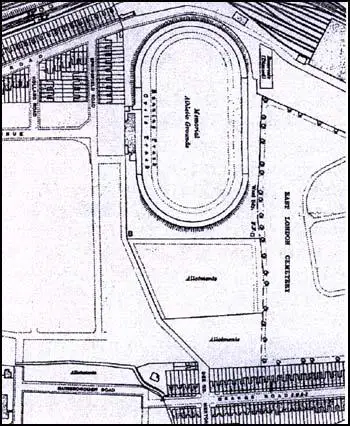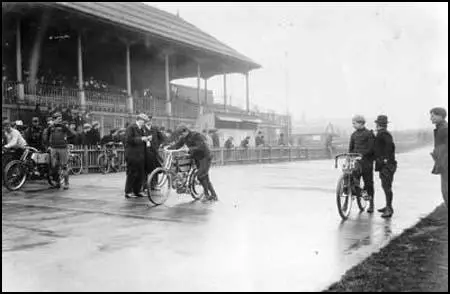The History of West Ham United
1896-1897
In 1896 the Thames Iron Works entered the London League. The team played in 'Royal Cambridge Blue' shirts and white shorts. They also wore a red cap, belt and socks.
The team had lost its star player, William Barnes, who had joined the league club Sheffield United. However, the club could still call upon the services of Robert Stevenson, Charlie Dove, Walter Tranter, George Gresham, William Chapman and George Sage. David Furnell, who worked as a labourer at the Thames Iron Works, also played his first game for the club. So also did George Neil, who had been playing local football with West Norwood.
The club secretary, Francis Payne, also signed Edward Hatton (Reading), Johnny Morrison (South West Ham), Fred Chalkley (Park Grove), Frank Dandridge and Peter Davie. The club now had enough players to field three teams every week. Payne also entered the first-team into six cup competitions.
Arnold Hills continued to take a close interest in the fortunes of the club. At the beginning of the season he sent a message to every member of the team: "As an old footballer myself, I would say, get into good condition at the beginning of the season, keep on the ball, play an unselfish game, pay heed to your captain, and whatever the fortunes of the first half of the game, never despair of winning, and never give up doing your very best to the last minute of the match. That is the way to play football, and better still, that is the way to make yourselves men."
Tom Robinson was the team's trainer. He had originally worked with Castle Swifts. According to the reports at the time, on the Monday following a match, the players would go on a brisk walk to free up stiff joints. Later that week they would spend time sprinting and running long distances to build up their stamina. Players also used a punchball and weights to strengthen the upper body. Only a short period was spent training with the ball.
By 1896 most football teams had adopted a basic formation comprising 2 full backs, 3 half backs and 5 forwards. The Irons regular line-up that season was H. Graham (goalkeeper), Robert Stevenson and George Neil (fullbacks), Frank Dandridge, Dick Bird and William Morton (half-backs), John Morrison, Charles Read, H. Butterworth, George Gresham and Peter Davie. Walter Tranter and Fred Chalkley covered the full-back position. Charlie Dove filled in wherever he was needed whereas Edward Hatton and Alex Cowie were replacement forwards. William Chapman and George Sage, two of the stars the winning West Ham Charity Cup Final Team, only got a couple of games that season.
The Irons had a warm-up friendly against Chatham. They were beaten 9-0 and goalkeeper Graham, who had been one of the heroes of the West Ham Charity Cup final the previous season, had a bad game and was dropped from the side.
Soon after the start of the season the club was evicted from the Hermit Road ground for violating their terms of tenancy by erecting a perimeter fence and charging admission to matches. Arnold Hills arranged to lease a piece of land at the junction of Byron Avenue and Browning Road in East Ham. In 1896 this was a huge undeveloped area.
Alf Chalk of Barking Woodville was sent off in a game against Thames Ironworks. Chalk, who was born in Plaistow and worked as a railway clerk, was one of the best players in the area. Three years later Chalk was a member of the Upton Park team that represented Great Britain and beat France in the 1900 Olympic football tournament final.
In 1897 Arnold Hills opened the headquarters of the Thames Ironworks Federated Clubs in Barking Road. Francis Payne was appointed to run the organization. Hills described Payne as the "indefatigable worker connected with the Federated Clubs and who is primarily responsible for the existence" of the institution."
Thames Iron Works lost 8-0 to Sheppey United in the first round of the FA Cup. The Irons goalkeeper, Southwood, was now replaced by Alex Duff, who had played for Scottish League side, Cowlairs, in the early 1890s. He in turn was replaced by David Furnell who played in the final game of the season against Barking Woodville.
The Irons lasted longer in the London Senior Cup and was finally knocked out by Bromley, 2-0, on 13th February, 1897. Thames Iron Works had a successful season in the league and after winning seven out of their 12 games finished second to 3rd Grenadier Guards. George Gresham, George Sage, Charlie Dove, Johnny Morrison, Charles Read and Edward Hatton all scored goals for the Hammers.

Attendances at the East Ham ground was disappointing. At the end of the season Arnold Hills announced that he had purchased land at Canning Town, Hills built what became known as the Memorial Grounds. It cost £20,000 to build and was considered to be one of the best stadiums in the country. Hills claimed it could hold 133,000 spectators and applied to hold an F.A. Cup Final at the Memorial Grounds. This only allowed 16 inches for each person and the Football Association turned the idea down.
Hills wanted to hold other sporting events, including cycling and athletics. As well as a football arena, it also had a cinder running track, tennis courts and an outdoor swimming pool. According to one report, the 100 feet (30.4m) long pool was the largest in England. The Memorial Grounds was opened in June, 1897. Hills made a speech where he pointed out that it had "the largest cycle track in London where they would hold such monster meetings that the attention of the Metropolis would be called to the Thames Ironworks".
The site had been chosen because it was planned to build Manor Road railway station close to the stadium. Unfortunately the project was delayed and it was not finished until four years later. This meant that attendances at the ground were much lower than expected.

